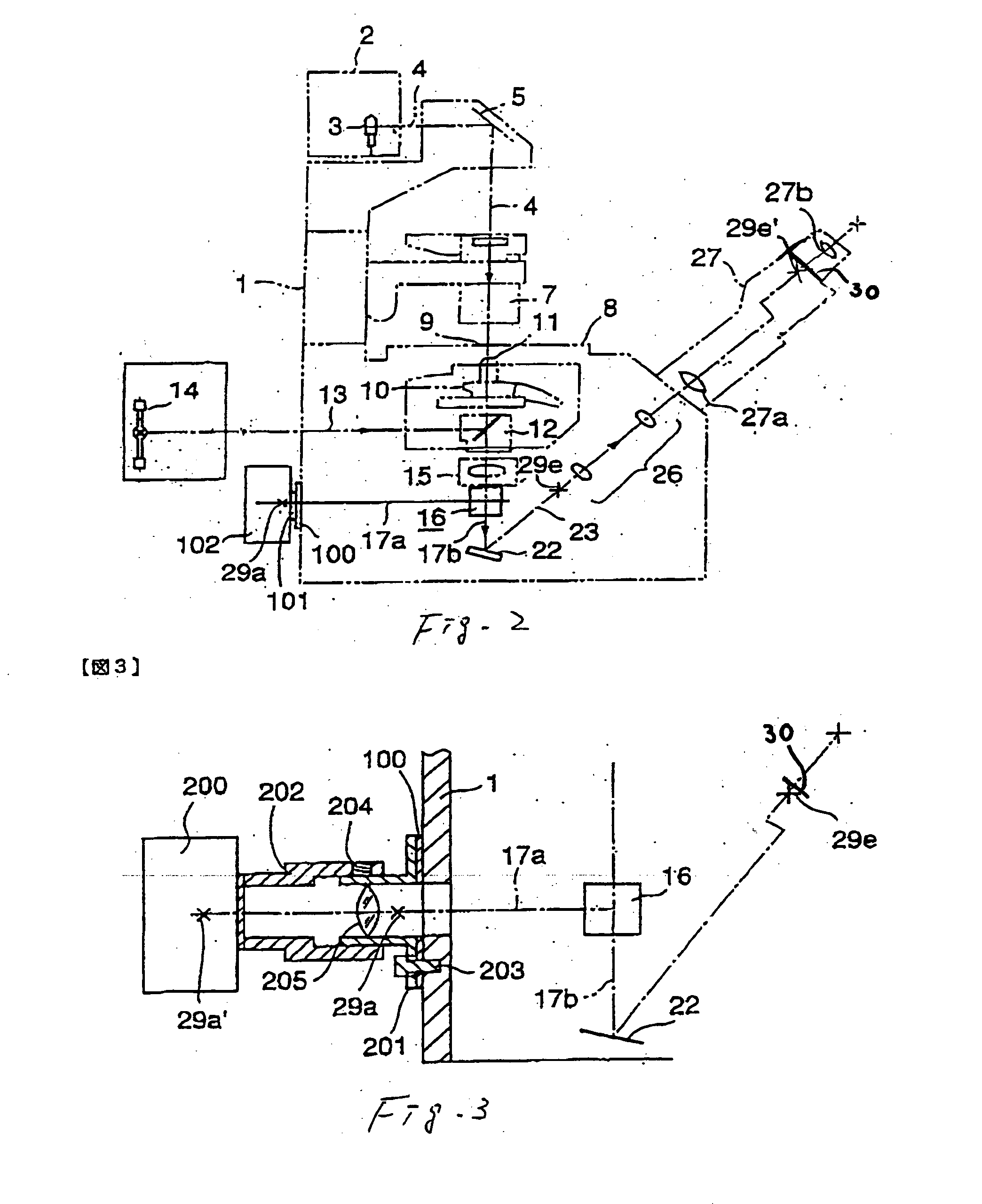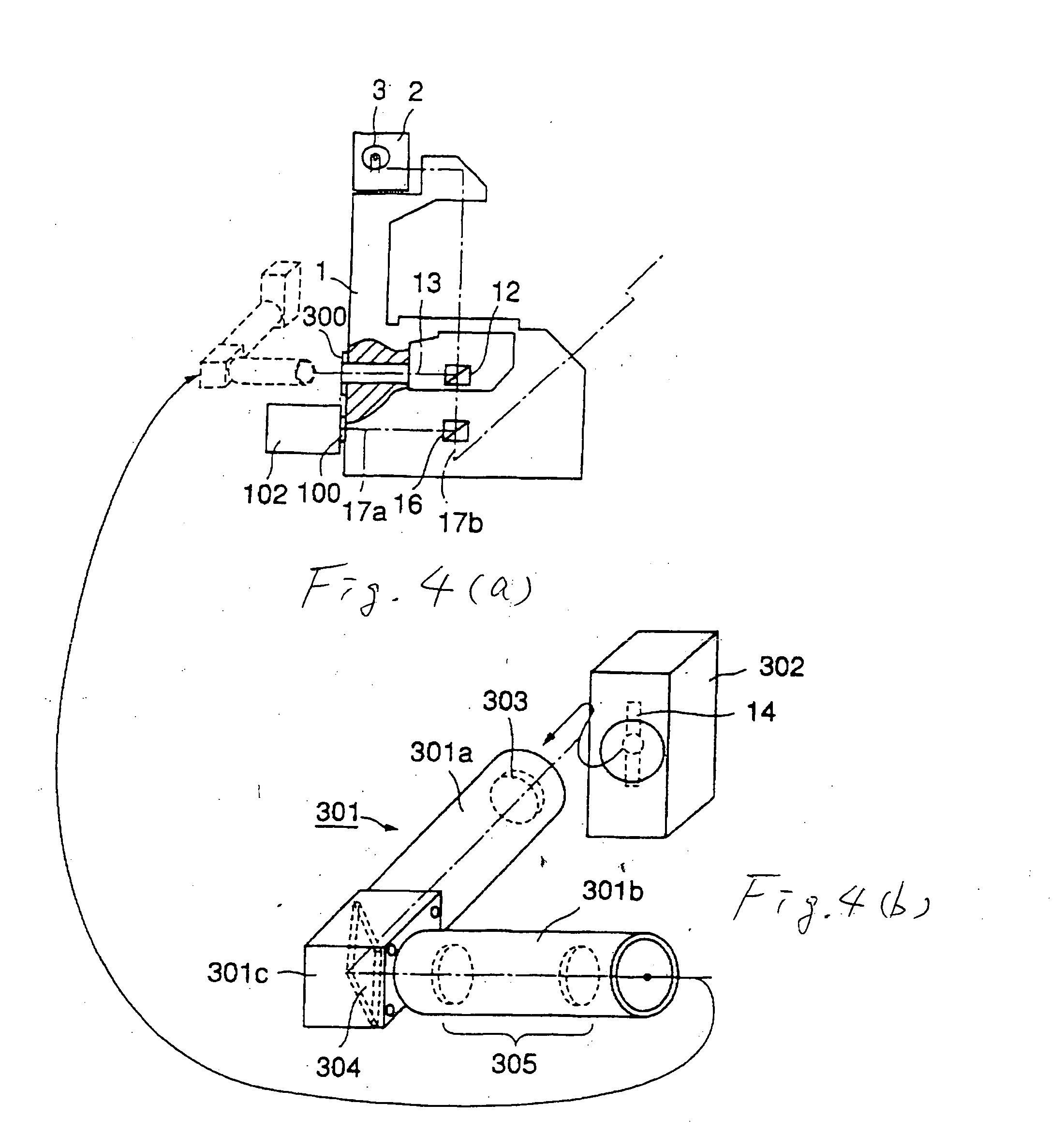An inverted microscope
a microscope and inverted technology, applied in the field of microscopes, can solve the problems of inability to precisely operate the cell, inability to measure current, and inability to physically interfere with the tv camera by micromanipulator,
- Summary
- Abstract
- Description
- Claims
- Application Information
AI Technical Summary
Problems solved by technology
Method used
Image
Examples
first embodiment
[0038] As explained above, this first embodiment includes the backside port 100 set in the backside of the frame 1, and the TV camera 102 attached to the backside port 100 by using the adapter 101. As a result, a micromanipulator of the type explained in connection with the prior art does not have physical interference with the TV camera 102, and may be operated precisely even if the micromanipulator is placed in the side space of the inverted microscope. In addition, by using the primary image as the image for the TV camera, a good quality image can be observed by the TV camera 102. That is, to take a weak observation image with high efficiency, an image based on the primary image is better than one based on the secondary image.
[0039] Furthermore, by using the backside port 100, it is not necessary to make a hole in a desk to locate the TV camera, and to provide a structure to insert between the desk and the bottom face of the microscope to raise the microscope. As a result, the eq...
second embodiment
[0042] FIGS. 3 shows a schematic diagram of a substantial part of the inverted microscope of the invention. The components in FIG. 3 that are the same as those in FIGS. 1, and 2 are given the same reference numbers.
[0043] A typical inverted microscope includes a photo mask attached to the imaging port disposed in the observation optical path 17b, or a scale glass as explained in connection with the first embodiment. Either the photo mask or the scale glass can be inserted into the observation optical path 17b to be disposed in the focal plane which is one of the primary focal plane and the second focal plane. In this way, an image of the sample 9, which overlaps the photo mask or the scale glass, can be seen by the eye. In this case, checking of the image area of the camera is done indirectly by using the photo mask. Therefore, it is necessary that the center of the optical axis of the camera is aligned with the center of the photo mask. Also, the camera must be attached so that the...
third embodiment
[0056] In this third embodiment, it is easy to attach the TV camera 102 to the backside port 100.
[0057] FIGS. 4(a), and 4(b) a schematic diagram of a substantial part of a third embodiment of the inverted microscope of the invention. The components in FIGS. 4(a), and 4(b) that are the same as those in FIGS. 1 and 2 are given the same reference numbers.
[0058] In FIGS. 4(a) and 4(b), the TV camera 102 is attached to the backside port 100, and an adapter 300 is placed in the position of the optical path of the reflected illumination light system 13. Also, the adapter 300 is placed at the backside of the frame 1. A reflected illuminator 301 is attached to the adapter 300. The reflected illuminator 301 is removable to the adapter 300. The reflected illuminator 301 includes a first reflected illuminator 301a, a second reflected illuminator 301b, and a relay tube 301c, which couples the first reflected illuminator 301a and the second reflected illuminator 301b. The first reflected illumin...
PUM
 Login to View More
Login to View More Abstract
Description
Claims
Application Information
 Login to View More
Login to View More - R&D
- Intellectual Property
- Life Sciences
- Materials
- Tech Scout
- Unparalleled Data Quality
- Higher Quality Content
- 60% Fewer Hallucinations
Browse by: Latest US Patents, China's latest patents, Technical Efficacy Thesaurus, Application Domain, Technology Topic, Popular Technical Reports.
© 2025 PatSnap. All rights reserved.Legal|Privacy policy|Modern Slavery Act Transparency Statement|Sitemap|About US| Contact US: help@patsnap.com



